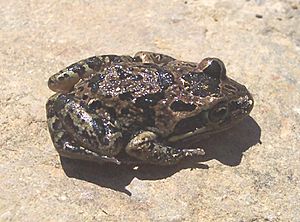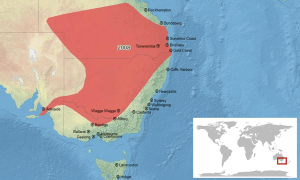Long-thumbed frog facts for kids
Quick facts for kids Long-thumbed frog |
|
|---|---|
 |
|
| Conservation status | |
| Scientific classification | |
 |
|
| Synonyms | |
|
List
Limnodynastes marmoratus (Lamb, 1911)
Opisthodon fletcheri (Wells & Wellington, 1985) Opisthodon lambi (Wells & Wellington, 1985) |
The long-thumbed frog is also known as Fletcher's frog or the barking marsh frog. Its scientific name is Limnodynastes fletcheri. This frog lives on the ground and does not dig burrows. It is found in south-eastern Australia. The long-thumbed frog belongs to a group of frogs called Limnodynastes. There are twelve species in this group. These frogs do not have special pads on their toes. Scientists have studied how this frog is related to others. They found it is closely related to frogs like the Spotted grass frog and the Striped marsh frog.
Contents
What Does the Long-Thumbed Frog Look Like?
The long-thumbed frog is a medium-sized frog. It grows to about 50 mm (2 inches) long. Its skin is usually grey or brown. It has darker patches or spots that are not perfectly shaped. Many of these frogs have a special butterfly-shaped mark between their eyes. You might also see a red or purplish spot above each eye.
This frog looks a lot like the Spotted grass frog (L. tasmaniensis). The best way to tell them apart is by their call. The long-thumbed frog has a white belly. Its eardrum, called the tympanum, is not very easy to see.
Where Do Long-Thumbed Frogs Live?
This frog lives in drier areas of Australia. You can find it west of the Great Dividing Range in New South Wales. It also lives in southern Queensland, northern Victoria, and eastern South Australia.
Long-thumbed frogs like to live near rivers, dams, and creeks. These water sources are often in woodlands and grasslands. Sometimes, these water bodies dry up. During dry times, the frogs hide under rocks. They also hide in cracked mud or in burrows made by yabbies.
Life Cycle and Behavior
Male long-thumbed frogs make a sound like a dog's "rok" or "whrup". They call from grassy areas near water. This usually happens after it rains or when water levels are high. They call during spring, summer, and autumn.
Breeding mostly happens after heavy rain. The female frog lays her eggs in a foamy mass that floats on the water. This foamy mass is often attached to plants. Eggs and tadpoles are usually found in water that is still or moving slowly. Tadpoles can grow quite large, up to 69 mm.
These frogs are "opportunistic breeders". This means they can breed whenever conditions are right. Because of this, tadpoles can change into frogs (metamorphosis) at any time of the year. The tadpoles look very similar to those of the Limnodynastes tasmaniensis. It is hard to tell them apart until they become frogs.
Keeping Long-Thumbed Frogs as Pets
In Australia, you can keep this type of frog as a pet. However, you need to have a special license to do so.
Protecting the Long-Thumbed Frog
The long-thumbed frog population is considered 'Least Concern' by the IUCN. This means their numbers are stable and they are not currently in danger. However, they are still threatened by habitat loss. This happens when their natural homes are destroyed.
Changes in how rivers flow also affect these frogs. For example, dams can change water levels. Long-thumbed frogs need floods between September and December to breed successfully. This helps more frogs survive and keeps the species healthy. So, managing river flows to allow for floods is important for their future.
See also
 In Spanish: Limnodynastes fletcheri para niños
In Spanish: Limnodynastes fletcheri para niños



